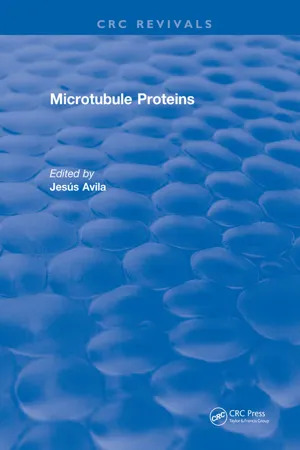![]()
Chapter 1
Dynamic Aspects of Microtubule Assembly
Yves Engelborghs
Table of Contents
- I. Introduction
- II. Components of the System
- A. Tubulin
- B. Microtubule-Associated Proteins
- C. Microtubules
- D. Rings
- III. Assembly Conditions
- IV. Polymorphism
- V. Polymerization Analysis According to Oosawa
- A. Equilibrium Analysis
- B. Kinetics
- VI. Kinetics of Microtubule Assembly
- A. Nucleation
- B. Intermediates
- C. Kinetics of Growth
- D. Disassembly Kinetics
- E. Relaxation Kinetics
- F. Discriminating the Two Ends
- VII. Kinetic Events at Steady State
- A. Incorporation of Protein or Nucleotide
- B. Hydrolysis
- C. Disassembly
- D. Role of T-GDP
- E. Dynamic Instability
- F. Annealing
- VIII. Oscillations
- IX. In Vivo Dynamics
- X. Conclusions
- Acknowledgments
- References
I. Introduction
This chapter on microtubule dynamics is conceived as a review of the major paradigms that have governed this research field. In this way I hope to transmit some of the thrill of the field, as well as an important consideration: whenever a measurement was made directly instead of indirectly, a surprising observation was made and totally new aspects of the system appeared.
The dynamics of the formation of microtubules can be studied by a variety of techniques. All of them reveal a different aspect of the total process, and a full picture will be obtained when all these pieces can be integrated into a single mechanism. In this chapter the mechanism of microtubule assembly will be divided in sequential conceptual steps. The contribution of the different techniques to the understanding of these steps will be given.
The initial analysis of microtubule assembly in vitro is based on the theory of Oosawa,1 which had been successfully applied to the study of actin polymerization. It remains the basic framework to which regular reference will be made. Therefore, it will be discussed in some detail. Aspects not directly related to microtubule dynamics will only be discussed very briefly and can be found more extensively in excellent reviews.2-5
II. Components of the System
Since the structure of the final polymeric product is a source of inspiration for the pathway of assembly, we will describe the microtubule structure here, as well as the basic components of the system.
A. Tubulin
The major constituent of the microtubule system is the protein tubulin. It is the association product of two different subunits: α and β tubulin. Both have a molecular weight of 50,000 Da and are highly homologous.6,7 The word tubulin always refers to the α-β heterodimer. This is usually considered as one unit, although the association is only due to noncovalent interactions. Detrich and Williams8 determined the dissociation constant by equilibrium sedimentation and found a value of 8(±3) x 10-7 M. This implies that at a tubulin concentration of 2 μΜ about 24% of the protein is dissociated into the two subunits. This measurement has, however, only been done in one particular buffer condition: in 0.1 M PIPES buffer, 1 mM MgSO4 at pH 6.9. It is conceivable that the different buffer conditions that influence polymerization also influence dimer formation. This remains to be investigated.
In relation to polymerization it is important to mention that tubulin has two binding sites for GTP, only one of them allows free exchange with nucleotide in solution (the E-site). At this Ε-site, GTP is hydrolyzed during assembly.9,10 It has been shown that the Ε-site is situated on the β subunit with a photoaffinity analogue of GTP,11 or by direct UV illumination of GTP-tubulin (T-GTP).12 Tubulin is a rather unstable protein. At room temperature its polymerizability is lost within a couple of hours.
Electrophoretic analysis indicates that tubulin consists of many isoforms.13 Some of them show tissue specificity and the genetic regulation of their expression is the subject of intensive research (see other chapters in this book). Tubulin is also subjected to posttranslational modifications, e.g., detyrosination.14
B. Microtubule-Associated Proteins
During the process of the isolation of microtubules, by repeated cycles of polymerization-depolymerization, certain proteins copurify. These proteins are called the microtubule-associated proteins (MAPs).15-17 They can be separated from tubulin by ion exchange chromatography,17 whereby care has to be taken not to remove the necessary Mg2+ ions.18 Originally these proteins were considered to be impurities of the preparation. However, their role as cofactor for polymerization became soon undisputable.19 Their association to microtubules in vivo was further proven by the use of specific antibodies.20
The mixture of MAPs has been divided into two classes on the basis of their molecular weight...
